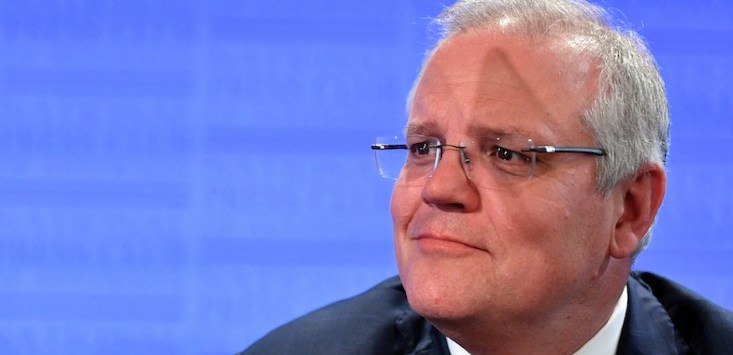
Prime Minister Scott Morrison. Source: AAP/Mick Tsikas.
Culture has once again been the topic of conversation these past few weeks. It has taken the courage of several individuals to shine a light on workplace practices that not only physically threaten lives, but also create an environment of mistrust and fear.
Parliament House isn’t the first and won’t be the last example of a toxic workplace but it now has an opportunity to correct course. The government must act now if it wishes to salvage its reputation and retain the services of the good people that it has working there.
Like many organisations, however, it’s likely to walk down a well-trodden path. An external review (or two) will be commissioned, humility may be shown when it is are published, someone will stand up and publicly say that ‘culture is the most important thing’ and then nothing will be done with the recommendations bar some legislation or policy change.
In a 2015 independent review, Professor Peter Shergold had this to say about the way things get done within the Australian Public Service: “Legislation will not change culture: people and their actions do.”
When it comes to culture, reviews and reports can shed some light on what needs to change; but it’s only when leaders stop ignoring poor behaviour and conduct and choose to take action, that things actually do.
The ownership of culture
Culture is the sum of everyone’s beliefs, attitudes, skills and behaviours. It doesn’t belong to senior leaders or the HR department (if there is one) — although the latter may be the custodian of it.
Culture is defined by every human interaction inside or outside the office, every process, every tradition, the nature of the work being undertaken and the skills or otherwise of those responsible for it.
It is also defined by every lost temper, every missed deadline, every award won and every target hit. Contrary to popular belief, culture is not hard to change once people have been taught how to define it, know how to uphold it and then constantly evolve it for the better. When none of these things are done — when there is no real commitment to culture — then it’s likely to end up on the front pages at some stage.
What does seem hard for many leaders, however, is the ability to follow a process to manage people whose behaviours undermine that culture.
Australia and New Zealand, like many other countries, aren’t very good at this. Instead, leaders make apologies or worse, excuses for people’s behaviour and fail to take action that would bring about lasting change.
How many more times will we hear that stress, pressure, being away from home, alcohol etc are the root causes of toxic culture, rather than the inhumane way that people treat others.
Things are so bad here that former prime minister Malcolm Turnbull had to remind senior ministers (many of whom were married with children) not to sleep with junior staffers. The standards were changed, but did the behaviours follow?
Culture change requires change from senior leaders
We’re not on our own. There are many global cases of poor leadership leading to toxic cultures. Travis Kalanick at Uber, Sepp Blatter at FIFA and Martin Winterkorn at Volkswagen are three such people who failed to realise — until it was too late in Kalanick’s case — that as leaders they are wholly accountable for the culture.
By allowing themselves or others to walk past the behaviours that undermine their staff’s psychological safety, they threaten the very thing that makes an organisation successful. All organisational success stems from its culture.
Improved productivity, improved sales, improved delivery of projects, improved customer satisfaction and reduced risk of physical injury are all attributable to how people treat each other.
Leaders need to heed the lessons from these stories and focus on three things:
- Put your money and time where your mouth is — stop talking about culture being the most important thing and provide staff with the time and money to define it. Provide support to help them be more self-aware, agree on the behaviours they expect of each other and how they’ll work together to deliver to their customers. Then help to hold them accountable to these agreements.
- Open your ears — culture is all around you. In order to find out what’s really going on, talk to people and just listen. Show empathy, compassion, humility and understanding. Make culture a key metric for the senior leadership team (rather than individual measures) and teach yourself how to positively evolve culture. Make it your goal to create more leaders that know how to build and maintain great culture.
- Deal with the transgressors — where you have instances of poor performance or there are people who seek to undermine the safety of others within a culture, they need to be dealt with swiftly and fairly. Regardless of whether that person has been there four minutes or 40 years, no one should make anyone else feel afraid to come to work or undermine the quality of what others do.
In a report at the end of last year, the Australian Institute of Company Directors called on CEOs and boards to start taking culture seriously.
“Defining expected culture [is] a precursor to requiring employees to behave in line with the desired culture,” it said.
Those behaviours start and end with senior leaders.



COMMENTS
SmartCompany is committed to hosting lively discussions. Help us keep the conversation useful, interesting and welcoming. We aim to publish comments quickly in the interest of promoting robust conversation, but we’re a small team and we deploy filters to protect against legal risk. Occasionally your comment may be held up while it is being reviewed, but we’re working as fast as we can to keep the conversation rolling.
The SmartCompany comment section is members-only content. Please subscribe to leave a comment.
The SmartCompany comment section is members-only content. Please login to leave a comment.